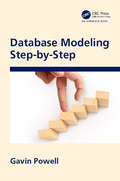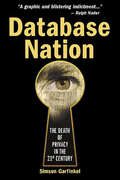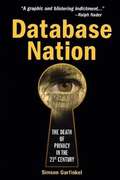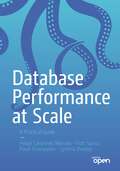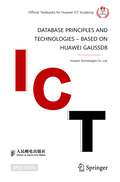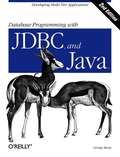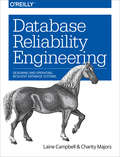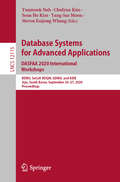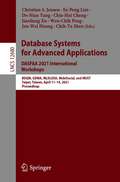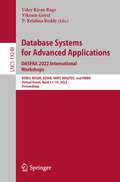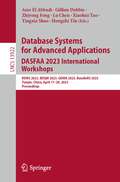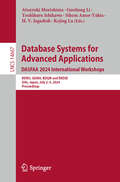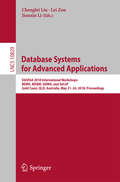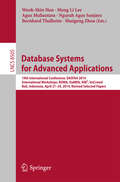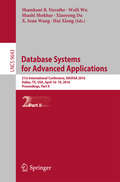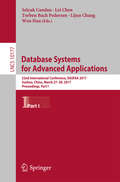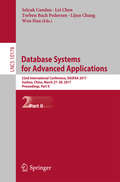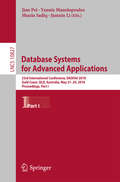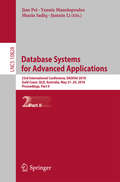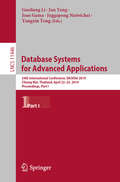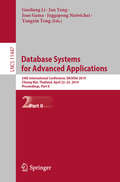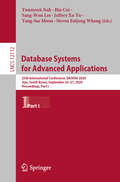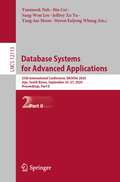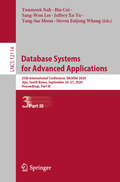- Table View
- List View
Database Modeling Step by Step
by Gavin PowellWith the aim of simplifying relational database modeling, Database Modeling Step-by-Step presents the standard approach to database normalization and then adds its own approach, which is a more simplistic, intuitive way to building relational database models. Going from basics to contemporary topics, the book opens with relational data modeling and ends with BigData database modeling following a road map of the evolution in relational modeling and including brief introductions to data warehousing and BigData modeling. A break-down of the elements of a model explains what makes up a relational data model. This is followed by a comparison between standard normalization and a more simplistic intuitive approach to data modeling that a beginner can follow and understand. A brief chapter explains how to use the database programming language SQL (Structured Query Language), which reads from and writes to a relational database. SQL is fundamental to data modeling because it helps in understanding how the model is used. In addition to the relational model, the last three chapters cover important modern world topics including denormalization that leads into data warehouses and BigData database modeling. The book explains how there is not much to logical data modeling in BigData databases because as they are often schema-less, which means that BigData databases do not have schemas embedded into the database itself, they have no metadata and thus not much of a logical data model. Online bonus chapters include a case study that covers relational data modeling and are available at the author’s web site: www.oracletroubleshooter.com/datamodeling.html
Database Nation: The Death of Privacy in the 21st Century
by Simson GarfinkelFifty years ago, in 1984, George Orwell imagined a future in which privacy was demolished by a totalitarian state that used spies, video surveillance, historical revisionism, and control over the media to maintain its power. Those who worry about personal privacy and identity--especially in this day of technologies that encroach upon these rights--still use Orwell's "Big Brother" language to discuss privacy issues. But the reality is that the age of a monolithic Big Brother is over. And yet the threats are perhaps even more likely to destroy the rights we've assumed were ours.Database Nation: The Death of Privacy in the 21st Century shows how, in these early years of the 21st century, advances in technology endanger our privacy in ways never before imagined. Direct marketers and retailers track our every purchase; surveillance cameras observe our movements; mobile phones will soon report our location to those who want to track us; government eavesdroppers listen in on private communications; misused medical records turn our bodies and our histories against us; and linked databases assemble detailed consumer profiles used to predict and influence our behavior. Privacy--the most basic of our civil rights--is in grave peril.Simson Garfinkel--journalist, entrepreneur, and international authority on computer security--has devoted his career to testing new technologies and warning about their implications. This newly revised update of the popular hardcover edition of Database Nation is his compelling account of how invasive technologies will affect our lives in the coming years. It's a timely, far-reaching, entertaining, and thought-provoking look at the serious threats to privacy facing us today. The book poses a disturbing question: how can we protect our basic rights to privacy, identity, and autonomy when technology is making invasion and control easier than ever before?Garfinkel's captivating blend of journalism, storytelling, and futurism is a call to arms. It will frighten, entertain, and ultimately convince us that we must take action now to protect our privacy and identity before it's too late.
Database Nation: the Death of Privacy in the 21st Century
by Simson GarfinkelDiscusses the many ways in which individual privacy has been and is being eroded, as personal information is gathered and stored without your knowledge.
Database Performance at Scale: A Practical Guide
by Felipe Cardeneti Mendes Piotr Sarna Pavel Emelyanov Cynthia DunlopDiscover critical considerations and best practices for improving database performance based on what has worked, and failed, across thousands of teams and use cases in the field. This open access book provides practical guidance for understanding the database-related opportunities, trade-offs, and traps you might encounter while trying to optimize data-intensive applications for high throughput and low latency. Whether you are building a new system from the ground up or trying to optimize an existing use case for increased demand, this book covers the essentials.The book begins with a look at the many factors impacting database performance at the extreme scale that today’s game changing applications face—or at least hope to achieve. You’ll gain insight into the performance impact of both technical and business requirements, and how those should influence your decisions around database infrastructure and topology. The authors share an inside perspective on often-overlooked engineering details that could be constraining—or helping—your team’s database performance. The book also covers benchmarking and monitoring practices by which to measure and validate the outcomes from the decisions that you make.The ultimate goal of the book is to help you discover new ways to optimize database performance for your team’s specific use cases, requirements, and expectations.What You Will LearnUnderstand often overlooked factors that impact database performance at scaleRecognize data-related performance and scalability challenges associated with your project Select a database architecture that’s suited to your workloads, use cases, and requirementsAvoid common mistakes that could impede your long-term agility and growthJumpstart teamwide adoption of best practices for optimizing database performance at scaleWho This Book Is ForIndividuals and teams looking to optimize distributed database performance for an existing project or to begin a new performance-sensitive project with a solid and scalable foundation. This will likely include software architects, database architects, and senior software engineers who are either experiencing or anticipating pain related to database latency and/or throughput.
Database Principles and Technologies – Based on Huawei GaussDB
by Huawei Technologies Co., Ltd.This open access book contains eight chapters that deal with database technologies, including the development history of database, database fundamentals, introduction to SQL syntax, classification of SQL syntax, database security fundamentals, database development environment, database design fundamentals, and the application of Huawei’s cloud database product GaussDB database. This book can be used as a textbook for database courses in colleges and universities, and is also suitable as a reference book for the HCIA-GaussDB V1.5 certification examination. The Huawei GaussDB (for MySQL) used in the book is a Huawei cloud-based high-performance, highly applicable relational database that fully supports the syntax and functionality of the open source database MySQL. All the experiments in this book can be run on this database platform. As the world’s leading provider of ICT (information and communication technology) infrastructure and smart terminals, Huawei’s products range from digital data communication, cyber security, wireless technology, data storage, cloud computing, and smart computing to artificial intelligence.
Database Programming with JDBC and Java, 2nd Edition
by George ReeseJava and databases make a powerful combination. Getting the two sides to work together, however, takes some effort--largely because Java deals in objects while most databases do not. This book describes the standard Java interfaces that make portable object-oriented access to relational databases possible and offers a robust model for writing applications that are easy to maintain. It introduces the JDBC and RMI packages and uses them to develop three-tier applications (applications divided into a user interface, an object-oriented logic component, and an information store). The book begins with a quick overview of SQL for developers who may be asked to handle a database for the first time. It then explains how to issue database queries and updates through SQL and JDBC. It also covers the use of stored procedures and other measures to improve efficiency, where these are available. But the book's key contribution is a set of patterns that let developers isolate critical tasks like object creation, information storage and retrieval, and the committing or aborting of transactions. The second edition includes more basics of JDBC and SQL, with more examples, and a deeper discussion about the architecture of a robust, maintainable database application. The second edition also explains the relationship between JDBC and Enterprise JavaBeans.
Database Programming with JDBC and Java, Second Edition
by George ReeseThis book describes the standard Java interfaces that make portable object-oriented access to relational databases possible, and offers a robust model for writing applications that are easy to maintain. The second edition has been completely updated for JDBC 2.0, and includes reference listings for JDBC and the most important RMI classes. The book begins with a quick overview of SQL for developers who may be asked to handle a database for the first time, and goes on to explain how to issue database queries
Database Reliability Engineering: Designing and Operating Resilient Database Systems
by Laine Campbell Charity MajorsThe infrastructure-as-code revolution in IT is also affecting database administration. With this practical book, developers, system administrators, and junior to mid-level DBAs will learn how the modern practice of site reliability engineering applies to the craft of database architecture and operations. Authors Laine Campbell and Charity Majors provide a framework for professionals looking to join the ranks of today’s database reliability engineers (DBRE).You’ll begin by exploring core operational concepts that DBREs need to master. Then you’ll examine a wide range of database persistence options, including how to implement key technologies to provide resilient, scalable, and performant data storage and retrieval. With a firm foundation in database reliability engineering, you’ll be ready to dive into the architecture and operations of any modern database.This book covers:Service-level requirements and risk managementBuilding and evolving an architecture for operational visibilityInfrastructure engineering and infrastructure managementHow to facilitate the release management processData storage, indexing, and replicationIdentifying datastore characteristics and best use casesDatastore architectural components and data-driven architectures
Database Systems for Advanced Applications. DASFAA 2020 International Workshops: BDMS, SeCoP, BDQM, GDMA, and AIDE, Jeju, South Korea, September 24–27, 2020, Proceedings (Lecture Notes in Computer Science #12115)
by Yang-Sae Moon Yunmook Nah Steven Euijong Whang Chulyun Kim Seon Ho KimThe LNCS 12115 constitutes the workshop papers which were held also online in conjunction with the 25th International Conference on Database Systems for Advanced Applications in September 2020.The complete conference includes 119 full papers presented together with 19 short papers plus 15 demo papers and 4 industrial papers in this volume were carefully reviewed and selected from a total of 487 submissions.DASFAA 2020 presents this year following five workshops: The 7th International Workshop on Big Data Management and Service (BDMS 2020) The 6th International Symposium on Semantic Computing and Personalization (SeCoP 2020) The 5th Big Data Quality Management (BDQM 2020) The 4th International Workshop on Graph Data Management and Analysis (GDMA 2020) The 1st International Workshop on Artificial Intelligence for Data Engineering (AIDE 2020)
Database Systems for Advanced Applications. DASFAA 2021 International Workshops: BDQM, GDMA, MLDLDSA, MobiSocial, and MUST, Taipei, Taiwan, April 11–14, 2021, Proceedings (Lecture Notes in Computer Science #12680)
by Ee-Peng Lim Jianliang Xu Wen-Chih Peng Christian S. Jensen De-Nian Yang Chia-Hui Chang Jen-Wei Huang Chih-Ya ShenThis volume constitutes the papers of several workshops which were held in conjunction with the 26th International Conference on Database Systems for Advanced Applications, DASFAA 2021, held in Taipei, Taiwan, in April 2021. The 29 revised full papers presented in this book were carefully reviewed and selected from 84 submissions. DASFAA 2021 presents the following five workshops: 6th International Workshop on Big Data Quality Management (BDQM 2021)5th International Workshop on Graph Data Management and Analysis (GDMA 2021) First International Workshop on Machine Learning and Deep Learning for Data Security Applications (MLDLDSA 2021)6th International Workshop on Mobile Data Management, Mining, and Computing on Social Network (MobiSocial 2021)2021 International Workshop on Mobile Ubiquitous Systems and Technologies (MUST 2021)Due to the Corona pandemic this event was held virtually.
Database Systems for Advanced Applications. DASFAA 2022 International Workshops: BDMS, BDQM, GDMA, IWBT, MAQTDS, and PMBD, Virtual Event, April 11–14, 2022, Proceedings (Lecture Notes in Computer Science #13248)
by P. Krishna Reddy Vikram Goyal Uday Kiran RageThis volume constitutes the papers of several workshops which were held in conjunction with the 27th International Conference on Database Systems for Advanced Applications, DASFAA 2022, held as virtual event in April 2022. The 30 revised full papers presented in this book were carefully reviewed and selected from 65 submissions. DASFAA 2022 presents the following five workshops: · First workshop on Pattern mining and Machine learning in Big complex Databases (PMBD 2021) · 6th International Workshop on Graph Data Management and Analysis (GDMA 2022) · First International Workshop on Blockchain Technologies (IWBT2022) · 8th International Workshop on Big Data Management and Service (BDMS 2022) · First workshop on Managing Air Quality Through Data Science · 7th International Workshop on Big Data Quality Management (BDQM 2022).
Database Systems for Advanced Applications. DASFAA 2023 International Workshops: BDMS 2023, BDQM 2023, GDMA 2023, BundleRS 2023, Tianjin, China, April 17-20, 2023, Proceedings (Lecture Notes in Computer Science #13922)
by Hongzhi Yin Xiaohui Tao Zhiyong Feng Amr El Abbadi Lu Chen Gillian Dobbie Yingxia ShaoThis volume constitutes the papers of several workshops which were held in conjunction with the 28th International Conference on Database Systems for Advanced Applications, DASFAA 2023, held in Tanjin, China, in April 2023. The 23 revised full papers presented in this book were carefully reviewed and selected from 40 submissions. DASFAA 2023 presents the following four workshops: 9th International Workshop on Big Data Management and Service (BDMS 2023), 8th International Workshop on Big Data Quality Management (BDQM 2023); 7th International Workshop on Graph Data Management and Analysis (GDMA 2023); 1st International Workshop on Bundle-based Recommendation Systems (BundleRS 2023).
Database Systems for Advanced Applications. DASFAA 2024 International Workshops: BDMS, GDMA, BDQM and ERDSE, Gifu, Japan, July 2-5, 2024, Proceedings (Lecture Notes in Computer Science #14667)
by Yoshiharu Ishikawa Atsuyuki Morishima Guoliang Li Sihem Amer-Yahia H. V. Jagadish Kejing LuThis volume constitutes the papers of several workshops which were held in conjunction with the 29th International Conference on Database Systems for Advanced Applications, held in Gifu, Japan, during July 2-5, 2024. The 26 full papers and 9 short papers included in this book were carefully reviewed and selected from 43 submissions. DASFAA 2024 presents the following four workshops: The 10th International Workshop on Big Data Management and Service (BDMS 2024) The 9th International Workshop on Big Data Quality Management (BDQM 2024) The DASFAA 2024 Workshop on Emerging Results in Data Science and Engineering (ERDSE 2024) The 8th International Workshop on Graph Data Management and Analysis (GDMA 2024)
Database Systems for Advanced Applications: 14th International Conference, Dasfaa 2009, Brisbane, Australia, April 21-23, 2009: Proceedings (Lecture Notes in Computer Science #5667)
by Lei Zou Jianxin Li Chengfei LiuThis book constitutes the workshop proceedings of the 23rd International Conference on Database Systems for Advanced Applications, DASFAA 2018, held in Gold Coast, QLD, Australia, in May 2018. The 23 full papers presented were carefully selected and reviewed from 44 submissions to the four following workshops: the 5th International Workshop on Big Data Management and Service, BDMS 2018; the Third International Workshop on Big Data Quality Management, BDQM 2018; the Second International Workshop on Graph Data Management and Analysis, GDMA 2018; and the 5th International Workshop on Semantic Computing and Personalization, SeCoP 2018.
Database Systems for Advanced Applications: 19th International Conference, DASFAA 2014, International Workshops: BDMA, DaMEN, SIM³, UnCrowd; Bali, Indonesia, April 21--24, 2014, Revised Selected Papers (Lecture Notes in Computer Science #8505)
by Shuigeng Zhou Bernhard Thalheim Wook-Shin Han Mong Li Lee Agus Muliantara Ngurah Agus SanjayaThis book constitutes the workshop proceedings of the 19th International Conference on Database Systems for Advanced Applications, DASFAA 2014, held in Bali, Indonesia, in April 2014. The volume contains papers from 4 workshops, each focusing on hot topics related to database systems and applications: the Second International Workshop on Big Data Management and Analytics, BDMA 2014; the Third International Workshop on Data Management for Emerging Network Infrastructure, DaMEN 2014; the Third International Workshop on Spatial Information Modeling, Management and Mining, SIM³ 2014, and the DASFAA Workshop on Uncertain and Crowdsourced Data, UnCrowd 2014.
Database Systems for Advanced Applications: 21st International Conference, DASFAA 2016, Dallas, TX, USA, April 16-19, 2016, Proceedings, Part II (Lecture Notes in Computer Science #9643)
by Shashi Shekhar Hui Xiong X. Sean Wang Shamkant B. Navathe Weili Wu Xiaoyong DuThis two volume set LNCS 9642 and LNCS 9643 constitutesthe refereed proceedings of the 21st International Conference on DatabaseSystems for Advanced Applications, DASFAA 2016, held in Dallas, TX, USA, inApril 2016. The 61 full papers presented were carefully reviewed andselected from a total of 183 submissions. The papers cover the followingtopics: crowdsourcing, data quality, entity identification, data mining andmachine learning, recommendation, semantics computing and knowledge base,textual data, social networks, complex queries, similarity computing, graphdatabases, and miscellaneous, advanced applications.
Database Systems for Advanced Applications: 22nd International Conference, DASFAA 2017, Suzhou, China, March 27-30, 2017, Proceedings, Part I (Lecture Notes in Computer Science #10177)
by Wen Hua Torben Bach Pedersen Lijun Chang Selçuk Candan Lei ChenDASFAA is an annual international database conference, located in the Asia- Paci?cregion,whichshowcasesstate-of-the-artR & Dactivities in databases- tems and their applications. It provides a forum for technical presentations and discussions among database researchers, developers and users from academia, business and industry. DASFAA 2009, the 14th in the series, was held during April 20-23, 2009 in Brisbane, Australia. In this year, we carefully selected six workshops, each focusing on speci?c research issues that contribute to the main themes of the DASFAA conference. Thisvolumecontainsthe?nalversionsofpapersacceptedforthesesixworkshops that were held in conjunction with DASFAA 2009. They are: - First International Workshop on Benchmarking of XML and Semantic Web Applications (BenchmarX 2009) - Second International Workshop on Managing Data Quality in Collaborative Information Systems (MCIS 2009) - First International Workshop on Data and Process Provenance (WDPP 2009) - First International Workshop on Privacy-Preserving Data Analysis (PPDA 2009) - FirstInternationalWorkshoponMobileBusinessCollaboration(MBC2009) - DASFAA 2009 PhD Workshop All the workshops were selected via a public call-for-proposals process. The workshop organizers put a tremendous amount of e?ort into soliciting and - lecting papers with a balance of high quality, new ideas and new applications. We asked all workshops to follow a rigid paper selection process, including the procedure to ensure that any Program Committee members are excluded from the paper review process of any paper they are involved with. A requirement about the overall paper acceptance rate of no more than 50% was also imposed on all the workshops.
Database Systems for Advanced Applications: 22nd International Conference, DASFAA 2017, Suzhou, China, March 27-30, 2017, Proceedings, Part II (Lecture Notes in Computer Science #10178)
by Wen Hua Torben Bach Pedersen Lijun Chang Selçuk Candan Lei ChenDASFAA is an annual international database conference, located in the Asia- Paci?cregion,whichshowcasesstate-of-the-artR & Dactivities in databases- tems and their applications. It provides a forum for technical presentations and discussions among database researchers, developers and users from academia, business and industry. DASFAA 2009, the 14th in the series, was held during April 20-23, 2009 in Brisbane, Australia. In this year, we carefully selected six workshops, each focusing on speci?c research issues that contribute to the main themes of the DASFAA conference. Thisvolumecontainsthe?nalversionsofpapersacceptedforthesesixworkshops that were held in conjunction with DASFAA 2009. They are: - First International Workshop on Benchmarking of XML and Semantic Web Applications (BenchmarX 2009) - Second International Workshop on Managing Data Quality in Collaborative Information Systems (MCIS 2009) - First International Workshop on Data and Process Provenance (WDPP 2009) - First International Workshop on Privacy-Preserving Data Analysis (PPDA 2009) - FirstInternationalWorkshoponMobileBusinessCollaboration(MBC2009) - DASFAA 2009 PhD Workshop All the workshops were selected via a public call-for-proposals process. The workshop organizers put a tremendous amount of e?ort into soliciting and - lecting papers with a balance of high quality, new ideas and new applications. We asked all workshops to follow a rigid paper selection process, including the procedure to ensure that any Program Committee members are excluded from the paper review process of any paper they are involved with. A requirement about the overall paper acceptance rate of no more than 50% was also imposed on all the workshops.
Database Systems for Advanced Applications: 23rd International Conference, DASFAA 2018, Gold Coast, QLD, Australia, May 21-24, 2018, Proceedings, Part I (Lecture Notes in Computer Science #10827)
by Yannis Manolopoulos Shazia Sadiq Jianxin Li Jian PeiThis two-volume set LNCS 10827 and LNCS 10828 constitutes the refereed proceedings of the 23rd International Conference on Database Systems for Advanced Applications, DASFAA 2018, held in Gold Coast, QLD, Australia, in May 2018.The 83 full papers, 21 short papers, 6 industry papers, and 8 demo papers were carefully selected from a total of 360 submissions. The papers are organized around the following topics: network embedding; recommendation; graph and network processing; social network analytics; sequence and temporal data processing; trajectory and streaming data; RDF and knowledge graphs; text and data mining; medical data mining; security and privacy; search and information retrieval; query processing and optimizations; data quality and crowdsourcing; learning models; multimedia data processing; and distributed computing.
Database Systems for Advanced Applications: 23rd International Conference, DASFAA 2018, Gold Coast, QLD, Australia, May 21-24, 2018, Proceedings, Part II (Lecture Notes in Computer Science #10828)
by Yannis Manolopoulos Shazia Sadiq Jianxin Li Jian PeiThis two-volume set LNCS 10827 and LNCS 10828 constitutes the refereed proceedings of the 23rd International Conference on Database Systems for Advanced Applications, DASFAA 2018, held in Gold Coast, QLD, Australia, in May 2018.The 83 full papers, 21 short papers, 6 industry papers, and 8 demo papers were carefully selected from a total of 360 submissions. The papers are organized around the following topics: network embedding; recommendation; graph and network processing; social network analytics; sequence and temporal data processing; trajectory and streaming data; RDF and knowledge graphs; text and data mining; medical data mining; security and privacy; search and information retrieval; query processing and optimizations; data quality and crowdsourcing; learning models; multimedia data processing; and distributed computing.
Database Systems for Advanced Applications: 24th International Conference, DASFAA 2019, Chiang Mai, Thailand, April 22–25, 2019, Proceedings, Part I (Lecture Notes in Computer Science #11446)
by Jun Yang Yongxin Tong Guoliang Li Joao Gama Juggapong NatwichaiThis two-volume set LNCS 11446 and LNCS 11447 constitutes the refereed proceedings of the 24th International Conference on Database Systems for Advanced Applications, DASFAA 2019, held in Chiang Mai, Thailand, in April 2019. The 92 full papers and 64 short papers were carefully selected from a total of 501 submissions. In addition, 13 demo papers and 6 tutorial papers are included. The full papers are organized in the following topics: big data; clustering and classification; crowdsourcing; data integration; embedding; graphs; knowledge graph; machine learning; privacy and graph; recommendation; social network; spatial; and spatio-temporal. The short papers, demo papers, and tutorial papers can be found in the volume LNCS 11448, which also includes the workshops of DASFAA 2019.
Database Systems for Advanced Applications: 24th International Conference, DASFAA 2019, Chiang Mai, Thailand, April 22–25, 2019, Proceedings, Part II (Lecture Notes in Computer Science #11447)
by Jun Yang Yongxin Tong Guoliang Li Joao Gama Juggapong NatwichaiThis two-volume set LNCS 11446 and LNCS 11447 constitutes the refereed proceedings of the 24th International Conference on Database Systems for Advanced Applications, DASFAA 2019, held in Chiang Mai, Thailand, in April 2019. The 92 full papers and 64 short papers were carefully selected from a total of 501 submissions. In addition, 13 demo papers and 6 tutorial papers are included. The full papers are organized in the following topics: big data; clustering and classification; crowdsourcing; data integration; embedding; graphs; knowledge graph; machine learning; privacy and graph; recommendation; social network; spatial; and spatio-temporal. The short papers, demo papers, and tutorial papers can be found in the volume LNCS 11448, which also includes the workshops of DASFAA 2019.
Database Systems for Advanced Applications: 25th International Conference, DASFAA 2020, Jeju, South Korea, September 24–27, 2020, Proceedings, Part I (Lecture Notes in Computer Science #12112)
by Bin Cui Yang-Sae Moon Jeffrey Xu Yu Yunmook Nah Sang-Won Lee Steven Euijong WhangThe 4 volume set LNCS 12112-12114 constitutes the papers of the 25th International Conference on Database Systems for Advanced Applications which will be held online in September 2020. The 119 full papers presented together with 19 short papers plus 15 demo papers and 4 industrial papers in this volume were carefully reviewed and selected from a total of 487 submissions. The conference program presents the state-of-the-art R&D activities in database systems and their applications. It provides a forum for technical presentations and discussions among database researchers, developers and users from academia, business and industry.
Database Systems for Advanced Applications: 25th International Conference, DASFAA 2020, Jeju, South Korea, September 24–27, 2020, Proceedings, Part II (Lecture Notes in Computer Science #12113)
by Bin Cui Yang-Sae Moon Jeffrey Xu Yu Yunmook Nah Sang-Won Lee Steven Euijong WhangThe 4 volume set LNCS 12112-12114 constitutes the papers of the 25th International Conference on Database Systems for Advanced Applications which will be held online in September 2020. The 119 full papers presented together with 19 short papers plus 15 demo papers and 4 industrial papers in this volume were carefully reviewed and selected from a total of 487 submissions. The conference program presents the state-of-the-art R&D activities in database systems and their applications. It provides a forum for technical presentations and discussions among database researchers, developers and users from academia, business and industry.
Database Systems for Advanced Applications: 25th International Conference, DASFAA 2020, Jeju, South Korea, September 24–27, 2020, Proceedings, Part III (Lecture Notes in Computer Science #12114)
by Bin Cui Yang-Sae Moon Jeffrey Xu Yu Yunmook Nah Sang-Won Lee Steven Euijong WhangThe 4 volume set LNCS 12112-12114 constitutes the papers of the 25th International Conference on Database Systems for Advanced Applications which will be held online in September 2020. The 119 full papers presented together with 19 short papers plus 15 demo papers and 4 industrial papers in this volume were carefully reviewed and selected from a total of 487 submissions. The conference program presents the state-of-the-art R&D activities in database systems and their applications. It provides a forum for technical presentations and discussions among database researchers, developers and users from academia, business and industry.
